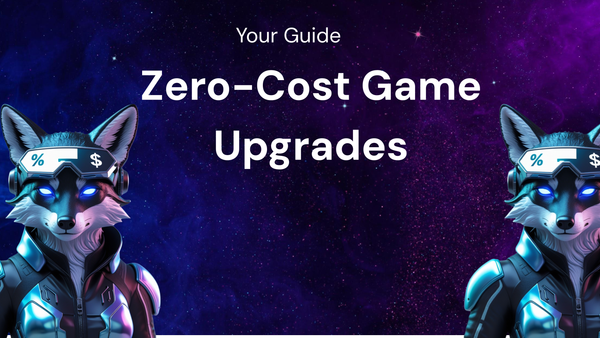How Ecommerce Trends Reveal the Best Time for Zero-Cost Upgrades

Decoding Ecommerce Trends: Unlocking the Perfect Time for Zero-Cost Upgrades
The world of ecommerce is a dynamic, ever-evolving landscape. Staying ahead of the curve requires constant monitoring of emerging trends, not just to identify potential new revenue streams, but also to pinpoint opportunities for cost-effective improvements. In particular, understanding how ecommerce trends impact user behavior and expectations can unlock the perfect timing for zero-cost upgrades – enhancements that improve customer experience, boost conversion rates, and ultimately, strengthen your brand without breaking the bank.
This article delves into the intricate relationship between ecommerce trends and zero-cost upgrades, providing a framework for identifying opportune moments to implement changes and maximizing their impact. We'll explore specific trends, discuss corresponding upgrade ideas, and outline a practical approach to integration, all while keeping budget constraints in mind.
I. Understanding the Power of Zero-Cost Upgrades
Before diving into the trends, let's define what we mean by "zero-cost upgrades." These aren't necessarily upgrades that require absolutely no time or effort; rather, they are improvements that leverage existing resources, free tools, or readily available features within your current platform to achieve significant results. They capitalize on strategic timing to leverage emerging trends and address evolving customer expectations without significant financial investment.
The benefits of strategically implemented zero-cost upgrades are numerous:
- Improved Customer Experience: Small, well-timed changes can have a disproportionately positive impact on customer satisfaction, leading to increased loyalty and repeat purchases.
- Enhanced Conversion Rates: Streamlining the checkout process, optimizing product pages, and personalizing the shopping experience can significantly boost conversion rates without adding extra expenses.
- Increased Brand Authority: Adapting to emerging trends and demonstrating a commitment to customer needs strengthens brand image and positions your business as forward-thinking and customer-centric.
- Competitive Advantage: In a crowded marketplace, even minor improvements can differentiate your brand and attract customers away from competitors who are slow to adapt.
- Data-Driven Optimization: Implementing changes based on observed trends allows you to gather valuable data and further refine your strategy for long-term growth.
II. Key Ecommerce Trends and Corresponding Zero-Cost Upgrade Opportunities
Now, let's explore some key ecommerce trends and identify practical zero-cost upgrades that can be implemented in response:
A. Trend: Personalization is Paramount
Customers increasingly expect personalized experiences. Generic marketing and one-size-fits-all product recommendations are becoming less effective.
- Zero-Cost Upgrade Opportunities:
- Segmented Email Marketing: Utilize email marketing platforms to segment your audience based on demographics, purchase history, browsing behavior, and other relevant criteria. Tailor email content to specific segments, offering personalized product recommendations, promotions, and content. Most platforms offer free tiers with segmentation capabilities.
- Personalized Product Recommendations (On-Site): Implement basic recommendation engines (often available within your ecommerce platform) that suggest products based on browsing history, past purchases, and similar customer behavior. Start with "customers who bought this also bought…" or "you might also like…" sections on product pages.
- Dynamic Content Based on Location: If applicable, display location-specific information, such as local store availability, regional promotions, or shipping options, based on the user's IP address. Many plugins and apps can handle this with minimal configuration.
- Welcome Emails with Personalized Offers: Craft engaging welcome emails for new subscribers, offering personalized discounts or product recommendations based on their initial browsing behavior.
- "Recently Viewed" Section: Implement a "recently viewed" section on your website to remind customers of products they've already shown interest in, encouraging them to revisit and potentially make a purchase.
B. Trend: Mobile-First Shopping is the Norm
Mobile commerce continues to dominate, with a significant portion of online sales originating from mobile devices. A seamless mobile experience is crucial.
- Zero-Cost Upgrade Opportunities:
- Mobile Responsiveness Testing: Regularly test your website's responsiveness across different mobile devices and screen sizes using free online tools like Google's Mobile-Friendly Test.
- Optimize Image Sizes for Mobile: Compress images to reduce file size and improve loading speed on mobile devices. Use free online image compression tools or plugins.
- Simplified Mobile Navigation: Ensure that your website navigation is clear, concise, and easy to use on mobile devices. Prioritize key menu items and use a mobile-friendly menu design (e.g., hamburger menu).
- One-Click Checkout Options: Enable one-click checkout options, such as Apple Pay or Google Pay, to streamline the purchasing process for mobile users.
- Mobile-Optimized Email Templates: Ensure that your email templates are responsive and display correctly on mobile devices.
C. Trend: Social Commerce is Booming
Social media platforms are increasingly becoming integral shopping destinations.
- Zero-Cost Upgrade Opportunities:
- Social Media Integration: Ensure that your website is seamlessly integrated with your social media channels. Include social sharing buttons on product pages and blog posts.
- Optimize Social Media Profiles: Optimize your social media profiles with clear branding, compelling descriptions, and links to your website.
- Engage with Followers: Actively engage with your followers on social media by responding to comments, answering questions, and running polls and quizzes.
- User-Generated Content: Encourage customers to share photos and videos of your products on social media using a branded hashtag. Feature user-generated content on your website and social media channels.
- Social Proof: Display customer reviews and testimonials on your website and social media channels to build trust and credibility.
D. Trend: The Rise of Video Commerce
Video content is highly engaging and effective for showcasing products and telling brand stories.
- Zero-Cost Upgrade Opportunities:
- Product Demonstrations: Create short, informative videos demonstrating how to use your products. Film them with a smartphone and edit them using free video editing software.
- Behind-the-Scenes Content: Share behind-the-scenes videos showcasing your company culture, manufacturing process, or team members.
- Customer Testimonials: Record video testimonials from satisfied customers.
- Product Unboxing Videos: Create unboxing videos that highlight the features and benefits of your products.
- Embed Existing Videos: Curate and embed relevant videos from other sources (e.g., YouTube reviews) on your product pages.
E. Trend: Sustainability and Ethical Consumption
Consumers are increasingly prioritizing sustainable and ethical brands.
- Zero-Cost Upgrade Opportunities:
- Highlight Sustainable Practices: Clearly communicate your sustainable practices on your website and in your marketing materials. This could include using eco-friendly packaging, sourcing sustainable materials, or supporting ethical labor practices.
- Transparent Supply Chain: Provide information about your supply chain, highlighting your commitment to ethical sourcing and responsible manufacturing.
- Partner with Eco-Friendly Organizations: Partner with environmental organizations or charities and donate a portion of your profits to support their work.
- Offer Sustainable Product Options: Promote sustainable product options and highlight their environmental benefits.
- Reduce Packaging: Minimize packaging waste by using smaller boxes and recycled materials.
F. Trend: Enhanced Customer Service Expectations
Customers expect fast, efficient, and personalized customer service.
- Zero-Cost Upgrade Opportunities:
- FAQ Page Optimization: Create a comprehensive and easy-to-navigate FAQ page that addresses common customer questions.
- Implement a Basic Chatbot: Utilize free chatbot platforms to provide instant answers to frequently asked questions.
- Automated Email Responses: Set up automated email responses to acknowledge customer inquiries and provide estimated response times.
- Social Media Monitoring: Monitor social media channels for customer mentions and respond promptly to questions and concerns.
- Improve Response Times: Strive to improve your response times to customer inquiries via email, phone, and social media.
III. A Practical Approach to Implementing Zero-Cost Upgrades
Identifying the right upgrade opportunities is just the first step. Here's a practical approach to implementing them effectively:
- Identify Relevant Trends: Stay informed about the latest ecommerce trends by reading industry blogs, attending webinars, and following thought leaders on social media. Pay attention to trends that are relevant to your specific industry and target audience.
- Analyze Your Current Performance: Use analytics tools to track your website traffic, conversion rates, bounce rates, and other key metrics. Identify areas where you can improve your customer experience and boost your sales.
- Prioritize Opportunities: Prioritize upgrade opportunities based on their potential impact and ease of implementation. Focus on changes that are likely to have the biggest impact on your bottom line and that can be implemented quickly and easily.
- Plan and Execute: Develop a detailed plan for implementing each upgrade. This plan should include specific goals, timelines, and resources.
- Test and Measure: After implementing each upgrade, test its effectiveness by tracking key metrics. Use A/B testing to compare different versions of your website and identify the most effective designs and content.
- Iterate and Improve: Continuously iterate and improve your upgrades based on your test results and customer feedback. The goal is to constantly refine your website and marketing efforts to provide the best possible customer experience.
IV. Tools and Resources for Zero-Cost Upgrades
Numerous free or low-cost tools and resources can help you implement zero-cost upgrades:
- Google Analytics: Track website traffic, conversion rates, and other key metrics.
- Google PageSpeed Insights: Analyze website speed and identify areas for improvement.
- Google's Mobile-Friendly Test: Test your website's responsiveness on mobile devices.
- Canva: Create professional-looking graphics for your website and social media channels.
- Mailchimp (Free Tier): Send email newsletters and marketing campaigns.
- HubSpot CRM (Free Tier): Manage customer relationships and track sales leads.
- ManyChat (Free Tier): Create a chatbot for your website or Facebook Messenger.
- Unsplash/Pexels: Access free, high-quality stock photos.
- Online Image Compression Tools: Compress images to reduce file size.
- Ecommerce Platform Built-in Features: Leverage features within your chosen platform for personalization, recommendations, and mobile optimization.
V. Examples of Successful Zero-Cost Upgrade Implementations
Let's look at a few hypothetical examples of how businesses have successfully implemented zero-cost upgrades:
- Scenario 1: Abandoned Cart Recovery: A small online clothing retailer noticed a high rate of abandoned carts. They implemented a simple abandoned cart email sequence using their existing email marketing platform (Mailchimp's free tier). They crafted a personalized email that included a picture of the abandoned items and offered a small discount (5%) to encourage completion of the purchase. This resulted in a significant increase in recovered sales.
- Scenario 2: Improving Mobile Conversion: A craft supply store noticed that a large percentage of their traffic came from mobile devices, but their mobile conversion rates were lagging. They used Google's Mobile-Friendly Test to identify areas for improvement. They then simplified their mobile navigation, optimized image sizes, and enabled one-click checkout options, resulting in a substantial boost in mobile conversions.
- Scenario 3: Leveraging User-Generated Content: An online beauty retailer encouraged customers to share photos of themselves using their products on Instagram using a branded hashtag. They then featured these photos on their website and social media channels, creating a sense of community and building social proof. This led to increased engagement and sales.
VI. Conclusion: Embracing the Agile Mindset
In conclusion, understanding ecommerce trends and identifying opportunities for zero-cost upgrades is essential for businesses that want to thrive in today's competitive landscape. By embracing an agile mindset and continuously adapting to evolving customer expectations, you can improve your customer experience, boost conversion rates, and strengthen your brand without breaking the bank. Remember to focus on data-driven decision-making, prioritize opportunities based on their potential impact, and leverage the many free or low-cost tools and resources that are available to you. The key is to be proactive, stay informed, and never stop looking for ways to improve your online business. By strategically implementing zero-cost upgrades, you can unlock significant value and achieve sustainable growth in the ever-evolving world of ecommerce.




